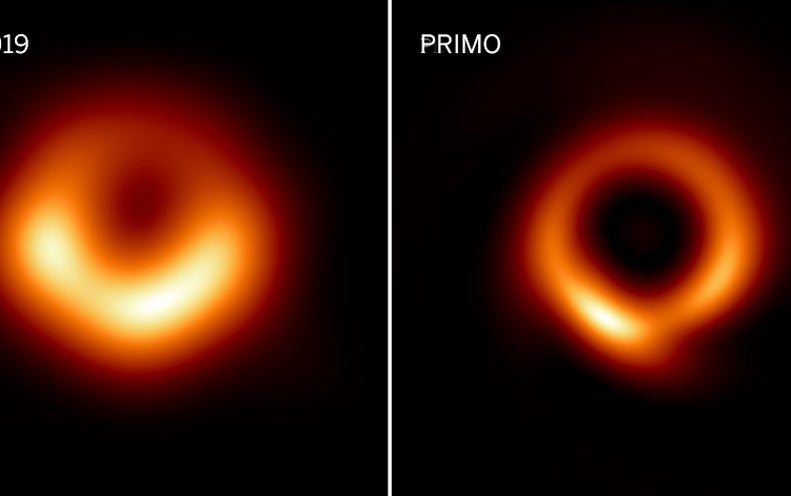The iconic first-ever view of a supermassive black hole sports a dramatic new look, thanks to machine learning.
The picture that captivated the world in 2019 showed a bright, blurry doughnut of light. But research published in the Astrophysical Journal Letters on April 13 sharpens that view into a narrow ring against a stark, black background. The new image lays the groundwork for future advances in our understanding of black holes, scientists say.
“I think they really are in this nice niche where you develop a specific algorithm for a specific problem and put in physical knowledge and make significant progress,” says Tiziana Di Matteo, an astrophysicist at Carnegie Mellon University, who uses machine learning in her own work and wasn’t involved in the new research. “This is a beautiful example of how things can improve, how you can see further, how you can see sharper, literally,” she says.
The galaxy M87 is located some 54 million light-years away from Earth. At its heart is a black hole that contains some 6.5 billion times the mass of our sun. That behemoth is one of two main targets of the Event Horizon Telescope (EHT), a coalition of radio observatories located around the globe. By combining data from these sources, scientists essentially constructed a telescope the size of Earth—powerful enough to capture details of bright matter swirling around the black hole.
But the EHT has a fundamental problem: its data are spotty, like a scene observed through a dirty window where light streamed through only a few patches. The 2019 image and its new companion were both based on data gathered from only a handful of locations on the planet, leaving big gaps in scientists’ view of the black hole.
That’s where machine learning comes in. Behind both the 2019 original and today’s enhanced view of M87’s black hole are imaging techniques that use machine learning to act as a sort of “mathematical detective,” says Kazunori Akiyama, an astrophysicist at the Massachusetts Institute of Technology’s Haystack Observatory, who is a member of the Event Horizon Telescope Collaboration but did not take part in the new research.
When scientists created the initial image, they relied on a generic machine-learning system to fill in the gaps. (Such a system, for instance, might decide that two neighboring pixels are more likely to be about the same brightness rather than vastly different.) When a distinctive ring-shaped image emerged from that process, that helped convince scientists that they were truly looking at a black hole. But the ring’s blurriness made learning more about the black hole difficult.
“Our thinking—and rightfully so—was that this is the very first time that anybody has seen a black hole, and we really wanted to not make any assumptions about that,” says Lia Medeiros, an astrophysicist at the Institute for Advanced Study in Princeton, N.J., and an author of the new research, who also helped create the 2019 image. “No human has ever seen this before, and so we didn’t want to assume that it’s going to be consistent with our theories.”
Confident that the EHT’s initial artificial-intelligence-augmented method had worked well for the 2019 image, Medeiros and her colleagues decided to up the ante with a subtly different and arguably more sophisticated substitute: a machine-learning approach they call principal-component interferometric modeling (PRIMO).
PRIMO runs on rules derived from what scientists expect black holes to look like, which the algorithm gleaned from training on a host of simulated black holes with varying characteristics—different masses, different spins, and so on. The result is a much more specialized algorithm.
“This is a completely new method,” Akiyama says. “They are using a different assumption for what kind of image is likely.”
Then Medeiros and her colleagues applied PRIMO to the same initial EHT data. The more physics-minded rules create a much sharper image depicting a narrower ring encircling a truly black center. And because scientists believe characteristics such as the ring’s width reflect fundamental features of the black hole, the sharper view could change scientists’ understanding of the massive object. The new research doesn’t delve deep into those potential implications, however. Papers that will do so are still in the works, Medeiros says.
And just like the iconic 2019 image, the new PRIMO image won’t be our last portrait of M87’s black hole. Akiyama wants to see the PRIMO algorithm tested more thoroughly, and Di Matteo emphasizes that the approach will become stronger as scientists continue to hone their understanding of the physics that govern black holes.
Ziri Younsi, an astrophysicist at University College London, who is a member of the Event Horizon Telescope Collaboration but did not take part in the new research, agrees. “Obviously, there’s more work which needs to be done to look at this algorithm and do more tests, but it’s potentially a very exciting result,” he says.

